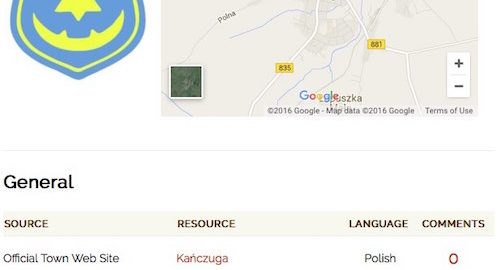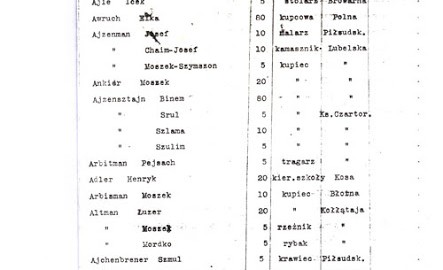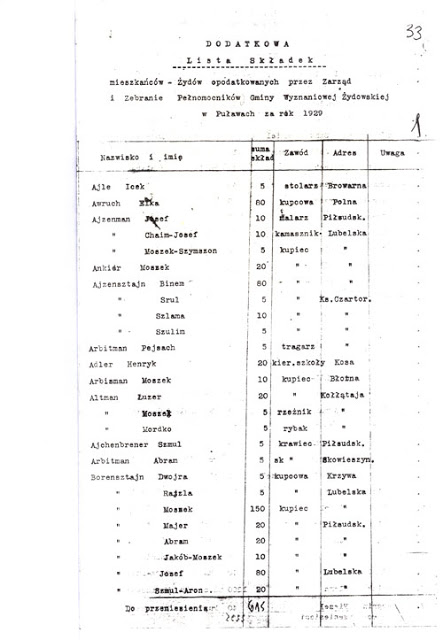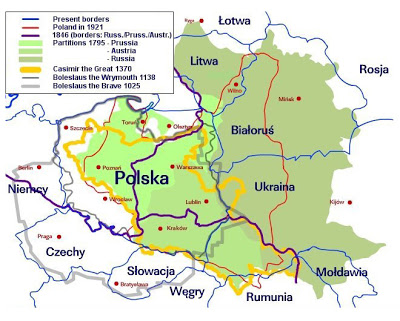When you enter the B&F Compendium of Jewish Genealogy, you are presented with a list of 207 countries. Among them, I’ve seeded those countries and their provinces with over 1,200 resources. Collecting those resources was time-consuming to say the least. At some point I decided, however, to go a step further and look into adding resources at the city level. I knew I couldn’t add resources for every city, town and village in the world, but I thought maybe I could do so for one country. I decided on Poland because I knew there were a number of unique city-level resources available. In general, I didn’t add one resource at a time, but rather hundreds at a time. Otherwise there would be no way to get to the 10,000 resources I added. I wanted to take a look at some of the sources I tapped in putting together the collection on this site.
One detail – I’m not making a distinction between cities, towns and villages – for the most part I use those terms interchangeable. Certainly most of the ‘cities’ for Poland are not more than towns, and in many cases tiny villages.
One of the hardest things in putting together the city-level resources for Poland was making sure all the records matched the correct cities. When trying to connect resources from many different sources, it was sometimes hard to make sure that the towns referenced were the same ones. Many towns in Poland use the same, or very similar names. At first, I thought I could use the Province/County information to identify each town, before I realized there was no place that had a good reference of all of them. JewishGen and Virtual Shtetl had the data for the pre-WWI period and/or the interwar period, but not the modern period. I felt it was important to anchor everything based on the modern province/county information, just as I felt it was important to only collect information on towns currently in Poland. There has to be a frame of reference for collecting all this information, and I wanted it to be the current country/province/county data. After I put together a list of towns I intended on collecting information on, I then did something a bit crazy. I found the Wikipedia pages for every town, in both the English and Polish versions. By finding the Wikipedia pages, I was able to add not only the Province (Voivodeship) and County (Powiat) to my database, but the latitude/longitude coordinates as well. Armed with the administrative divisions and the map coordinates, I had enough information to, in almost every case, match up the records I collected to the correct towns.
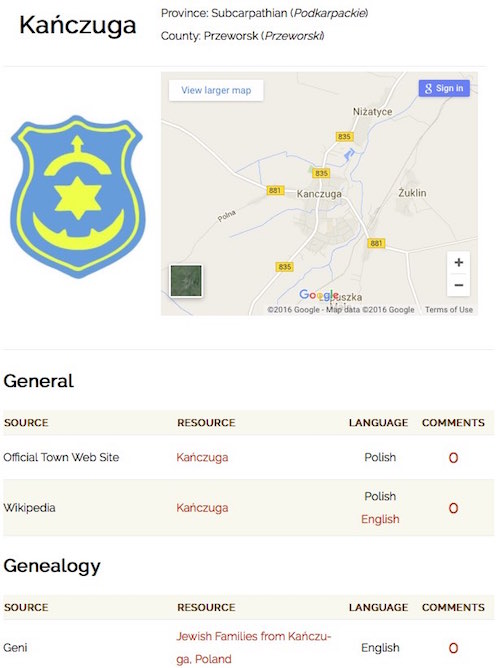
The Wikipedia entries, in addition to the official government sites for those towns, were added to a new section unique to cities, called General. Unlike almost all resources in the compendium, records in the General section are not specifically Jewish. Rather, they are intended as a kind of anchor point for the rest of the records, to insure we’re talking about the correct town. If you find a resource in the rest of the town section that doesn’t seem to match the town in the General section, then let me know. There are bound to be some mistakes. The General records are there, therefore, to help correct those mistakes.
One thing to note about the official town web sites. In addition to Poland having a province (voivodeship) and a county (powiat), there is also a third smaller district called a Gmina in Polish, sometimes translated as a Municipality or a Commune. In some cases the city itself doesn’t have a web site, rather the city web site is part of the Gmina web site. In cases where the Gmina has the same name as the town (very common), and no specific town site could be found, I linked to the Gmina web site. I did something similar with the Coat of Arms for towns in Poland. When I couldn’t find one for the town, if the town was in a Gmina of the same name, I used the Coat of Arms of the Gmina.
JewishGen provided four major groups of resources to Polish cities – the Community Database, the JewishGen Family Finder (JGFF), the Yikzor Book Project, and KehilaLinks. The other major resource groups included links from Virtual Shtetl, the IAJGS Jewish Cemetery Project, JRI-Poland, the Routes to Roots Foundation, Gesher Galicia, Geni, and two large Polish sites documenting Jewish cemeteries in Poland – Kirkuty.xip.pl and Złe miejsca dla ślimaków.
In addition to these major groups, each of which contributed hundreds of resources, there were hundreds of other individual resources collected from a variety of sites including landsmanshaft sites, individual cemetery sites, contemporary Jewish community sites, etc. While I tried not to stray off-course too much in collecting these individual records (I hoped rather that these kinds of records would be contributed by users after launch) I found it hard not to add uniques sites that I found.
Let’s a take a look at the major resource groups to help those who are unfamiliar with some or all of them (in alphabetical order):
Geni – While perhaps better known for their World Family Tree trying to connect everyone on the planet, Geni also offers user-created research projects. These projects can cover anything, but many of them cover specific communities that people want to research. Many research projects have been set up to research former Jewish communities, and those projects are what I’ve linked to in the compendium.
Gesher Galicia – Galicia was a region of the former Austrian Empire, which is now split between Poland and Ukraine. Gesher Galicia is a very active group researching Jewish families from that region, and collecting original records from archives in Poland and Ukraine and making them available in its All Galicia Database. Their town listing is automatically generated from information on each town including the pre-war administrative districts and map coordinates, and lists how many Gesher Galicia members have indicated they are researching each town (in their Gesher Galicia Family Finder).
IAJGS Jewish Cemetery Project – Often overlooked, the IAJGS Jewish Cemetery Project is a massive database trying to list every known Jewish cemetery on the planet. There is a huge amount of information contained in the database, although nothing about specific burials (that’s left to the JewishGen Online Worldwide Burial Registry, although there’s no way to link to information in JOWBR for a specific town). If you want to find out if a cemetery exists in your ancestral town and what condition it’s in, this is a good place to start.
JewishGen Communities Database – This is a database of towns worldwide with confirmed Jewish communities. Unlike the much larger JewishGen Gazetteer which has over a million localities in over 54 countries based on the U.S. Board on Geographic Names database, the JewishGen Communities Database is a curated list of roughly 6,000 towns where there is known to be, or have been, a Jewish community. For each town, the database links to other resources on JewishGen, as well as selected resources on other sites. The town pages have other very useful information, such as a list of the closest towns in the database to the current town, as well as alternate names for the town in different languages.
JewishGen Family Finder – The JewishGen Family Finder, or JGFF, is a significant resource for potentially finding other relatives. The idea is simple, you add a list of town/surname pairs to the database. If someone else is researching the same surname from the same town, then they will find you when searching the database, and hopefully contact you. I wrote about how to get started with the JGFF on the JewishGen blog back in 2011 (JewishGen Basics: The JewishGen Family Finder) and I recommend reading that post as an introduction if you haven’t used JGFF before.
JewishGen KehilaLinks – Originally known as ShetLinks (as in links to Shtetls), the KehilaLinks project is, for the most part, a attempt to create pages memorializing former Jewish communities. In some ways you can think of KehilaLink sites as modern version of Yizkor Books. The difference, perhaps, is that while Yizkor Books were published by former residents of their communities, at this point KehilaLink sites are being produced primarily by descendants of the residents of these communities. The amount of information available for each town varies wildly, as they are solely edited by volunteers for each town. If you have additional information to contriubte for your ancestral town, I recommend contacting the coordinator for your town and sending them your information to be added.
JewishGen Yizkor Book Project – An amazing project that seeks to collect information on all Yizkor Books published, extract lists of the dead (necrology lists) from them, and translate them. Yizkor Books were for the most part memorial books published by the survivors of communities destroyed during the Holocaust. These books were published in the decades following the Holocaust, frequently in Yiddish or Hebrew, mainly in the US and Israel where landsmanshaftn for these communities existed. Many of these books contain lists of those who were murdered during the Holocaust, memories about what it was like to live in the communities, photographs of people, etc. They are incredible resource that many people have not been able to leverage in their research due to their scarcity (they were privately published in small quantities for members of the community) and the language barrier, but this project is looking to make these books more readily available online, and to offer translations of some or all of each book online.
JRI-Poland – Formally Jewish Records Indexing – Poland, JRI-Poland is a decades-long effort spearheaded by Stanley Diamond to index and publish Jewish vital records from Poland (and places that were formerly part of Poland). Working with local archives in Poland and elsewhere, JRI-Poland has managed to index over 5 million records from over 550 towns. While the index can provide most of the information in a record, the records on JRI-Poland also give you the information you need to order copies of the records from the local archives. More recently as many of these records have gone online, JRI-Poland has linked directly to the digital copies of the records on Polish archive web sites. JRI-Poland’s town pages generally includes the map coordinates for the town, and sometimes the province. Links to off-site resources can include links to the JewishGen Communities Database and Virtual Shtetl. In addition to that basic information, the town page shows you what records exist in the local archives as well as in LDS microfilms (which sometimes overlap), and gives you information on fundraising for the various indexing projects for that town. To see what is actually indexed, however, you must search in their database.
Kirkuty.xip.pl – A kind of memorial to the pre-war Jewish community of Poland, this web site documents the current state of Jewish cemeteries across Poland. The site is, for the most part, only in Polish. Information is given on the history of the Jewish community in the town, and there are usually photographs of the current state of the cemetery and sometimes links to other related web sites.
Routes to Roots Foundation – The culmination of decades of research by Miriam Weiner, the Routes to Roots database contains information on what vital records and other documents covering Jewish communities exist in archives in Belarus, Lithuania, Moldova, Poland, Ukraine, and to a lesser extent Latvia, Romania and Russia. Originally published in two books written my Miriam Weiner (Jewish Roots in Poland, and Jewish Roots in Ukraine and Moldova), the information is kept up to date on the web site, and has been expanded over the years to include new records that have been found. When looking to see if any records exist for your ancestral town, this database is a good place to start. It’s worth mentioning that I link to the search results for the town, which might include records from other towns with matching names, so don’t automatically assume that records in these search results are from your town.
Virtual Shtetl – A project of the POLIN Museum of the History of Polish Jews, Virtual Shtetl is a large database of information of current and mostly former Jewish communities in Poland. The database of communities consists of 1971 towns, all either currently in, or formerly in, Poland. Basic information like the pre-WWII province/county and the map coordinates are provided for each community, as well as links to some other sites such as the JewishGen Community Database and JRI-Poland. While each town has different information, information can include information on the Jewish community, cemeteries, synagogues, people, landsmanshaftn, heritage cites, sites where Jews were murdered, etc. Most of the information is in Polish, although some has been translated into English. If you look on the English version of the site it will show you whether is in English, and when it comes to a resource with no translation it will show it to you in Polish.
Złe miejsca dla ślimaków – Roughly translated as ‘Bad place for snails’ this blog documents places near the author’s home in Pulawy, Poland. ‘Near’ seems to be a relative term, as the author has documented hundreds of towns. These places include cemeteries (both Jewish and non-Jewish) and buildings such as former synagogues and yeshivas. The site is completely in Polish, but provides information on the places it documents, and includes photos of each place. When documenting a cemetery, the resource shows up in the Cemeteries section. When documenting a building that was once a synagogue or yeshiva, I’ve placed the resource in the Contemporary section. That may be counterintuitive, but if the Synagogue is currently being used as a bar, then that is the contemporary representation of the former Jewish community in that town. I don’t think there are any examples of a town where there is a contemporary Jewish community and the former synagogue is being used for something not connected to the Jewish community, so it shouldn’t be too confusing.
Some examples of individual sites that I added include The World Society of Częstochowa Jews and their Descendants (see Częstochowa in the compendium), the Chelmer Organization in Israel (see Chełm in the compendium), and the Jewish Tarnow Facebook group (see Tarnów in the compendium).
If you represent another site that has a large number of town-specific information, contact me directly and I can share a spreadsheet that can be filled out to allow records to be added easily to the site. Even if you don’t represent a site, but if you think another existing site is worth adding and are willing to collect the information needed, be in touch. If you’re a site looking to utilize some of the information on this site, such as the province/county data I’ve collected, please also be in touch. My goal is to expand access to this information, and if that means helping other sites to improve, I’m more than happy to help them.
I hope people found this information useful, and that you will share this with your friends (perhaps on Facebook or Twitter?) who may not yet know about the availability of these resources. Let me know what you think in the comments below.
